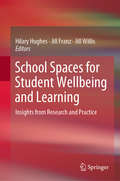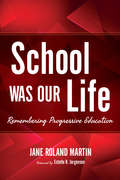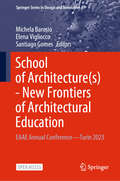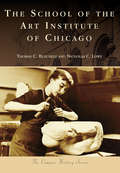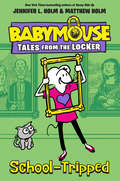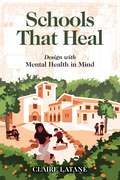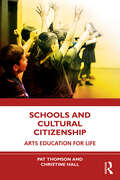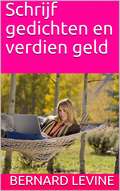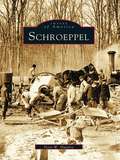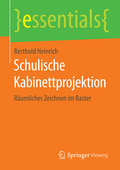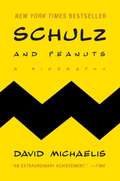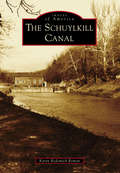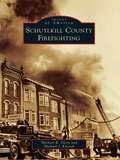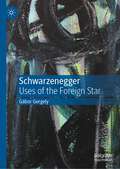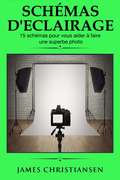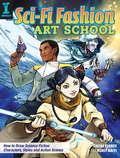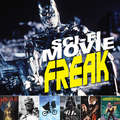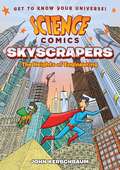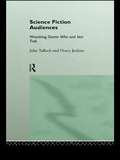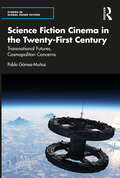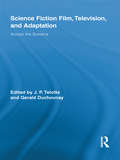- Table View
- List View
School Spaces for Student Wellbeing and Learning: Insights from Research and Practice
by Hilary Hughes Jill Franz Jill WillisThis book introduces a new wellbeing dimension to the theory and practice of learning space design for early childhood and school contexts. It highlights vital, yet generally overlooked relationships between the learning environment and student learning and wellbeing, and reveals the potential of participatory, values-based design approaches to create learning spaces that respond to contemporary learners’ needs. Focusing on three main themes it explores conceptual understandings of learning spaces and wellbeing; students’ lived experience and needs of learning spaces; and the development of a new theory and its practical application to the design of learning spaces that enhance student wellbeing. It examines these complex and interwoven topics through various theoretical lenses and provides an extensive, current literature review that connects learning environment design and learner wellbeing in a wide range of educational settings from early years to secondary school. Offering transferable approaches and a new theoretical model of wellbeing as flourishing to support the design of innovative learning environments, this book is of interest to researchers, tertiary educators and students in the education and design fields, as well as school administrators and facility managers, teachers, architects and designers.
School Was Our Life: Remembering Progressive Education (Counterpoints: Music and Education)
by Estelle R. Jorgensen Jane Roland MartinThe late 1930s and early 1940s were the peak of progressive education in the United States, and Elisabeth Irwin's Little Red School House in New York City was iconic in that movement. For the first time, stories and recollections from students who attended Little Red during this era have been collected by author Jane Roland Martin. Now in their late eighties, these classmates can still sing the songs they learned in elementary school and credit the progressive education they loved with shaping their outlooks and life trajectories. Martin frames these stories from the former students "tell it like it was" point of view with philosophical commentary, bringing to light the underpinnings of the kind of progressive education employed at Little Red and commenting critically on the endeavor. In a time when the role of the arts in education and public schooling itself are under attack in the United States, Martin makes a case for a different style of education designed for the defense of democracy and expresses hope that an education like hers can become an opportunity for all.
School of Architecture: EAAE Annual Conference—Turin 2023 (Springer Series in Design and Innovation #47)
by Michela Barosio Santiago Gomes Elena ViglioccoThis open access book gathers the latest advances and innovations in the field of architectural education, as presented at the 2023 annual conference of the European Association for Architectural Education (EAAE AC), “School of Architecture(s)”, held in Turin, Italy, on August 30–September 1, 2023.
School of the Art Institute of Chicago, The (Campus History)
by Nicholas C. Lowe Thomas C. BuecheleIn 2016, the School of the Art Institute of Chicago (SAIC) reached its 150th year. What sustains an institution is sometimes extraordinary, sometimes mundane, and often simply a matter of the sheer will of those involved. An unparalleled museum school, SAIC embodies something greater than the individuals who have passed through it, and yet it has also depended upon the unique and special nature of its protagonists—its founders who survived the Great Chicago Fire and rebuilt the school, a president who cast the hands and face of Abraham Lincoln, an alumna who was a celebrated illustrator and an activist in the women’s suffrage movement, the creators of monumental sculptures throughout the country, and numerous scholars of art history and technique—to challenge and shape its form. The school’s history is punctuated by marvelous moments of heightened public discourse in art making and scholarship. This book represents a glimpse into the lives of generations of students, staff, and faculty as full participants in an astounding learning environment.
School-Tripped (Babymouse Tales from the Locker #3)
by Jennifer L. HolmWatch out, Big City! Babymouse is on a field trip without a chaperone in the third book in the Babymousetastic, highly illustrated Babymouse: Tales from the Locker series.Babymouse's art class is headed to a museum in the Big City. And now that they're middle schoolers, she and her friends will be totally unsupervised! She can't wait to check out all the world-famous art...that is, until she overhears Felicia Furrypaws planning to ditch the museum and hit the town instead. Babymouse decides to test her freedom with an urban adventure of her own. Will she make it back to the museum before the bus leaves? Or will life in the Big City trip her up big-time?
Schooling in Modernity
by Paola BonifazioBetween 1948 and the end of the 1950s, Italian and American government agencies and corporations commissioned hundreds of short films for domestic and foreign consumption on topics such as the fight against unemployment, the transformation of rural and urban spaces, and the re-establishment of democratic regimes in Italy and throughout Europe. In Schooling in Modernity, Paola Bonifazio investigates the ways in which these sponsored films promoted a particular vision of modernization and industry and functioned as tools to govern the Italian people.The author uses extensive archival research and various theoretical approaches to examine the politics of sponsored filmmaking in postwar Italy. Among the many topics explored are target audiences and audience response, sources of funding, censorship, debates on cinematic realism, and the connections and differences between American and Italian strategies and styles of documentary filmmaking. Insightful and richly detailed, Schooling in Modernity shows the importance of these under-appreciated films in the postwar modernization process, the transition from Fascism to democracy, and Italy's involvement in the Cold War.
Schools That Heal: Design with Mental Health in Mind
by Claire LataneWhat would a school look like if it was designed with mental health in mind? Too many public schools look and feel like prisons, designed out of fear of vandalism and truancy. But we know that nurturing environments are better for learning. Access to nature, big classroom windows, and open campuses consistently reduce stress, anxiety, disorderly conduct, and crime, and improve academic performance. Backed by decades of research, Schools That Heal showcases clear and compelling ways—from furniture to classroom improvements to whole campus renovations—to make supportive learning environments for our children and teenagers. With invaluable advice for school administrators, public health experts, teachers, and parents Schools That Heal is a call to action and a practical resource to create nurturing and inspiring schools for all children.
Schools and Cultural Citizenship: Arts Education for Life
by Christine Hall Pat Thomson‘Why study the arts at school?’ This book offers a fresh perspective on this question. Informed by rigorous research, the book argues that the arts help young people to develop key skills, knowledge and practices that support them to become both critical appreciative audiences and socially engaged cultural producers. Drawing on a three-year study in partnership with the Royal Shakespeare Company and Tate, Cultural Citizenship sets out an ecological model for cultural citizenship that goes beyond the classroom, including families, the media and popular culture. The authors introduce new, interrelated concepts to change how we consider arts education. Chapters provide fresh insights, guidance and practical recommendations for educators, including: An introduction to the Tracking Arts Learning and Engagement research Detailed case studies featuring arts rich schools and arts-broker teachers Immersive professional development for teachers and the benefits of partnerships with arts organisations An ecological model for cultural citizenship Focusing on the ways in which cultural citizenship can be taught and learnt, this is an essential read for arts educators, education staff in arts organisations, researchers, postgraduate students, arts education activists and policy makers.
Schrijf gedichten en verdien geld
by Bernard LevineSchrijf je gedichten? Je kunt nu betaald worden voor de poëzie die je schrijft en je gedichten laten publiceren in wenskaarten, kalenders, posters en muurplaten. Als u uw schrijfdromen wilt waarmaken en geld wilt krijgen voor uw poëzie, is dit unieke boek speciaal voor u. Gedichten schrijven voor geld is heel leuk en zeer winstgevend! Krijg betaald om te doen waar je van houdt.
Schroeppel
by Peter W. HuntleyCarved out of the wilderness at the end of the Revolutionary War, Schroeppel is a central New York town located in the southern section of Oswego County. The town comprises the communities of Oak Orchard, Gilberts Mills, Pennellville, and Phoenix. Schroeppel presents the unique story of this town from the days of the Paleo Indians of eleven thousand years ago to the suburban growth that reached the town by the 1980s. With a selection of some two hundred photographs, the book portrays the daily life of farmers whose hard work built and sustained the town; the site of the first frame house in the town (that of George C. Schroeppel); Underground Railroad routes; and the place where tools and other implements of daily life were invented and perfected.
Schulische Kabinettprojektion: Räumliches Zeichnen im Raster (essentials)
by Berthold HeinrichBerthold Heinrich stellt die mathematischen und zeichnerischen Grundlagen für die Darstellung von Objekten im Raum auf kariertem Papier vor. Dabei präsentiert er auch die Nutzung von Software. In der Schule wird oft kariertes Papier als Raster zur Darstellung von Flächen und Körpern genutzt. Allerdings werden, selbst in einigen Druckwerken, z. B. die entstehenden Ellipsen und Winkelbögen ungenau gezeichnet oder eine Kugelkontur falsch als Kreis dargestellt. Im vorliegenden Essential werden die korrekten Verfahren sowohl theoretisch als auch an konkreten Beispielen vorgestellt und können meist direkt umgesetzt werden. Einige aufwändigere Abläufe stellt der Autor anschaulich an Beispielen dar.
Schuylkill Canal, The
by Karen Rodemich RomanIn 1825, the Schuylkill Navigation Company completed a waterway of 108 miles, linking Port Carbon to Philadelphia. The waterway, known as the Schuylkill Navigation but commonly referred to today as the Schuylkill Canal, consisted of a system of interconnected canals (often called reaches), locks, and slack-water pools to transport anthracite coal. Before that time, Philadelphia depended on the import of coal from Europe. The Schuylkill Canal was operational until 1931, around the time of the collapse of commercial traffic in the navigation. Only two watered stretches of the canal remain today: the approximately 2.5 miles of the original 3.5 miles of Oakes Reach between Oaks and Mont Clare and the one-mile reach in Manayunk. While these areas are no longer used for navigation, they are enjoyed recreationally by many in the surrounding communities.
Schuylkill County Firefighting (Images of America)
by Michael R. Glore Michael J. KitsockFrom the inception of the Friendship Hose Company No. 1 of Orwigsburg in 1820 to the organization of the West Penn Fire Company No. 1 in 1999, more than 130 volunteer fire companies have served Schuylkill County. This proud tradition of volunteer service for the protection of fellow man continues strong to this day as scores of volunteer firefighters continue to serve their communities. Using the archives of the Schuylkill County Historical Society, Schuylkill Historical Fire Society, and many fire companies and individuals, Schuylkill County Firefighting captures in its images the daunting challenges faced by generations of Schuylkill firefighters. Block-burning conflagrations, deadly explosions, and traumatic rescues reveal the heroic battles faced over the years by these dedicated public servants.
Schwarzenegger: Uses of the Foreign Star
by Gábor GergelyThis book analyses the uses of Arnold Schwarzenegger as a foreign star in Hollywood through a film philosophical, de-westernizing and sonic critical framework. It offers very close readings of the film texts, of the roles Schwarzenegger performs, and the rhetorical strategies he adopts outside his film performances to show that in spite of attempts to occupy the position of an emblematic member of the U.S. national body Schwarzenegger remains irrevocably outside as an accented migrant body continuously accumulating markers of belonging that by their very necessity attest to their insufficiency. The book’s central project is to trace back, from the uses to which a migrant star such as Schwarzenegger is put on the screen, the construction of a sense or idea of a U.S. national community through the cinema. Given that the appeal to the American myth of an immigrant nation that promises to erase difference is fundamental to the Schwarzenegger star persona, the central aim of this book is to explore the uses of his stardom as an embodiment of the promise of America and its contradictions and exclusions.
Schwinn: The Best Present Ever
by Don RaufFor many children of the sixties, the gift of a Schwinn was a ticket to freedom, a chance to feel the wind on their face and the steady rotation of rubber at their feet. The Schwinn took many through their childhood adventures, with memories filled of after school, free-range bike rides around the neighborhood with friends, the late afternoon sun shining off of the gleaming painted frame and stainless steel fenders.The 1960s and 70s saw a boom of Schwinn Sting-Rays, which appealed to young riders who had to have the hottest &“muscle&” bike in town, and sold like hotcakes to parents everywhere scrambling to get the best Christmas present ever for their kids.From its early years dominating the youth market with Sting-Rays to the teen-friendly Varsity and Continental models to its most recent parent-friendly iterations of the Easy-Steer and Roadster Trikes, the Schwinn weaves itself through 120 years of American history. For many, the Schwinn will be forever tied to the memories of their childhood, to a simpler time of freedom, laughter, and endless wonder.Schwinn: The Best Present Ever is a visual celebration of this American icon, with a complementary narrative throughout that tells the Schwinn story.
Schémas d'éclairage 15 schémas pour vous aider à faire une superbe photo
by James ChristiansenVous en avez des photographies trop sombres, trop claires ou tout simplement pas « comme il faut » ? Mes schémas d'éclairage vous aideront dès aujourd'hui à prendre de meilleures photos avec un éclairage optimal ! Prendre de superbes photos n'est pas si difficile, en particulier avec les incroyables avancées technologiques actuelles en matière d'appareil photo. L'un des concepts fondamentaux que vous devez comprendre est la manière de configurer correctement l'éclairage d'une photographie. Ce livre vous montrera exactement comment faire à l'aide de schémas d'éclairage faciles à suivre. Ce livre présente des schémas d'éclairage pour : 1. Portraits de bébé 2. Photos d'un seul sujet 3. Portraits de famille 4. Portraits en gros plan 5. Portraits d'animaux domestiques 6. Photos de produits (idéal pour eBay ou Craiglist !) 7. Portraits de silhouette Et bien plus encore, y compris encore plus de schémas et de conseils en matière équipement ! Arrêtez de prendre de mauvaises photos et commencez à prendre de superbes photos avec ces schémas d'éclairage simples !
Sci-Fi Fashion Art School: How to Draw Science Fiction Characters, Styles and Action Scenes
by Irene Flores Ashly RaitiYour guide to drawing sci-fi characters! From post-apocalyptic Earth to extraterrestrial civilizations, get ready to explore the farthest reaches of your imagination and evoke your own original sci-fi worlds. With Sci-Fi Fashion Art School you will learn to draw everything from scavenger-wear and exosuits to alien garb and space explorer uniforms. Starting with simple guidelines, you'll discover how to create distinct characters just by varying facial features, body mass and hair. Beyond the mechanics of drawing, you'll learn to make strategic creative choices by asking questions like: What drives your characters? Do they dress for survival or social status? What materials are at their disposal? The answers help you develop fashions, weapons and accessories uniquely suited to the environmental and cultural conditions of your particular world. The Sci-Fi genre has no limits. With the instruction and inspiration inside, neither will you. Launch Yourself Into New Worlds!Learn how to draw clothing, hairstyles, tools, weapons, jewelry, prosthetic parts, and more.Create characters, settings and scenes with 21 step-by-step demonstrationsExplore several different sci-fi world scenarios: The Wasteland, Urban Dystopia, iRobots and The Final Frontier.Develop a diverse cast of characters, including enforcers, scientists, survivors, rulers, rebels, servants, bad guys and others.
Sci-Fi Movie Freak
by Robert C. Ring"I'll be back." -- The Terminator, The Terminator (1984) To the movies, that is. And so will you with the help of Sci-Fi Movie Freak, a celebration of some of the greatest science-fiction movies of all time. Your inner geek will freak finding everything from classics like Metropolis, Forbidden Planet, and 2001: A Space Odyssey to modern movies including Avatar, Moon, and Inception, and even the entertaining "failures" like Robot Monster, Gammera the Invincible, and Battlefield Earth. Movies are divided into various chapters including Best of the Best, Further Essentials, and Lesser-Known Gems. Features more than 100 movies 250+ photos of movie stills and posters Top 10 lists of the best directors, female characters, villains and moreFree DVD included of the magnificently bad cult classic Plan 9 From Outer Space.
Science Arts: Exploring Science Through Hands-On Art Projects (Bright Ideas for Learning #4)
by Jean Potter MaryAnn F Kohl K. Whelan DeryGet ready to explore the world of science through art with these open-ended experiments! Science Arts introduces the scientific magic of crystals, light, constellations, plants, and more through creative art projects. Each of the more than 100 hands-on projects is designed to help children discover essential science topics through a creative process unique to each individual. Concepts include light and sight, motion and energy, and nature and ecology. Science Arts provides both teachers and parents with a diverse range of activities for making science creative, fun and fascinating. The possibilities are wide open and endless!
Science Comics: The Heights of Engineering (Science Comics)
by John KerschbaumLeave no brick unturned in John Kerschbaum's Science Comics: Skyscrapers, the latest volume in First Second’s action-packed nonfiction graphic novel series for middle-grade readers!Every volume of Science Comics offers a complete introduction to a particular topic—dinosaurs, the solar system, volcanoes, bats, robots, and more. These gorgeously illustrated graphic novels offer wildly entertaining views of their subjects. Whether you're a fourth grader doing a natural science unit at school or a thirty-year-old with a secret passion for airplanes, these books are for you!In this volume, join a pair of superheroes as they uncover the secrets of skyscrapers, from the great Egyptians pyramids to the world’s tallest building. Read along and learn how skyscrapers are a bold combination of applied physics, ingenuity, and a lot of hard work!
Science Fiction Audiences: Watching Star Trek and Doctor Who (Popular Fictions Series)
by Henry Jenkins John TullochScience Fiction Audiences examines the astounding popularity of two television "institutions" - the series Doctor Who and ^Star Trek. Both of these programmes have survived cancellation and acquired an following that continues to grow. The book is based on over ten years of research including interviews with fans and followers of the series. In that period, though the fans may have changed, and ways of studying them as "audiences" may have also changed, the programmes have endured intact, with Star Trek for example now in its fourth television incarnation. John Tulloch and Henry Jenkins dive into the rich fan culture surrounding the two series, exploring issues such as queer identity, fan meanings, teenage love of science fiction, and genre expectations. They encompass the perspectives of a vast population of fans and followers throughout Britain, Australia and the US, who will continue the debates contained in the book, along with those who will examine the historically changing range of audience theory it presents. and continue to attract a huge community of fans and followers. Doctor Who has appeared in nine different guises and Star Trek is now approaching its fourth television incarnation.Science Fiction Audiences examines the continuing popularity of two television 'institutions' of our time through their fans and followers. Through dialogue with fans and followers of Star Trek and Dr Who in the US, Britain and Australia, John Tulloch and Henry Jenkins ask what it is about the two series that elicits such strong and active responses from their audiences. Is it their particular intervention into the SF genre? Their expression of peculiarly 'American' and 'British' national cultures. Their ideologies and visions of the future, or their conceptions of science and technology? Science Fiction Audiences responds to a rich fan culture which encompasses debates about fan aesthetics, teenage attitudes to science fiction, queers and Star Trek, and ideology and pleasure in Doctor Who. It is a book written both for fans of the two series, who will be able to continue their debates in its pages, and for students of media and cultural studies, offering a historical overview of audience theory in a fascinating synthesis of text, context and audience study.
Science Fiction Cinema in the Twenty-First Century: Transnational Futures, Cosmopolitan Concerns (Studies in Global Genre Fiction)
by Pablo Gómez-MuñozRecent films are increasingly using themes and conventions of science fiction such as dystopian societies, catastrophic environmental disasters, apocalyptic scenarios, aliens, monsters, time travel, teleportation, and supernatural abilities to address cosmopolitan concerns such as human rights, climate change, economic precarity, and mobility. This book identifies and analyses the new transnational turn towards cosmopolitanism in science fiction cinema since the beginning of the twenty-first century. The book considers a wide selection of examples, including case studies of films such as Elysium, In Time, 2012, Andrew Niccol’s The Host, Codependent Lesbian Space Alien Seeks Same, and Cloud Atlas. It also questions the seeming cosmopolitanism of these narratives and exposes how they sometimes reproduce social hierarchies and exploitative practices. Dealing with diverse, interdisciplinary concerns represented in cinema, this book in the Studies in Global Genre Fiction series will be of interest to readers and scholars working in the fields of science fiction, film and media studies, cosmopolitanism, border theory, popular culture, and cultural studies. It will also appeal to fans of science fiction cinema and literature.
Science Fiction Cinema in the Twenty-First Century: Transnational Futures, Cosmopolitan Concerns (Studies in Global Genre Fiction)
by Pablo Gómez-MuñozRecent films are increasingly using themes and conventions of science fiction such as dystopian societies, catastrophic environmental disasters, apocalyptic scenarios, aliens, monsters, time travel, teleportation, and supernatural abilities to address cosmopolitan concerns such as human rights, climate change, economic precarity, and mobility. This book identifies and analyses the new transnational turn towards cosmopolitanism in science fiction cinema since the beginning of the twenty-first century.The book considers a wide selection of examples, including case studies of films such as Elysium, In Time, 2012, Andrew Niccol’s The Host, Codependent Lesbian Space Alien Seeks Same, and Cloud Atlas. It also questions the seeming cosmopolitanism of these narratives and exposes how they sometimes reproduce social hierarchies and exploitative practices.Dealing with diverse, interdisciplinary concerns represented in cinema, this book in the Studies in Global Genre Fiction series will be of interest to readers and scholars working in the fields of science fiction, film and media studies, cosmopolitanism, border theory, popular culture, and cultural studies. It will also appeal to fans of science fiction cinema and literature.
Science Fiction Film, Television, and Adaptation: Across the Screens (Routledge Research in Cultural and Media Studies)
by J. P. Telotte and Gerald DuchovnayWhile film and television seem to be closely allied screen media, our feature films and television series have seldom been successfully adapted across those screens. In fact, rather than functioning as portals, those allied media often seem, quite literally, screens that filter out something that made the source work so popular in its original form. Differences in budget, running times, cast, viewing habits, screen size and shape all come into play, and this volume’s aim is to track a number of popular texts in the course of their adaptive journeys across the screens in order to sketch the workings of that cross-media adaptation. For its specific examples, the volume draws on a single genre—science fiction—not only because it is one of the most popular today in either film or television, but also because it is arguably the most self-conscious of contemporary genres, and thus one that most obviously frames the terms of these technological adaptations. The essays included here mine that reflexive character, in both highly successful and in failed efforts at cross-media adaption, to help us understand what film and television achieve in screening science fiction, and to reveal some of the key issues involved in all of our efforts to navigate the various screens that have become part of contemporary culture.
